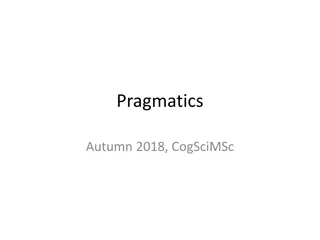Grice's Theory of Implicature: Types, Properties, and Diagnostic Tests
Grice's theory of implicature distinguishes between types of implicatures - conventional and conversational. Conversational implicatures are context-dependent and motivated by conversational maxims, leading to generalized and particularized implicatures. Generalized conversational implicatures are driven by Grice's maxims and typically do not violate them. Scalar implicatures involve non-maximal degree modifiers, triggering inferences based on scales. The indefinite article can also trigger implicatures about possession based on whether the noun is alienable or inalienable.
Download Presentation

Please find below an Image/Link to download the presentation.
The content on the website is provided AS IS for your information and personal use only. It may not be sold, licensed, or shared on other websites without obtaining consent from the author.If you encounter any issues during the download, it is possible that the publisher has removed the file from their server.
You are allowed to download the files provided on this website for personal or commercial use, subject to the condition that they are used lawfully. All files are the property of their respective owners.
The content on the website is provided AS IS for your information and personal use only. It may not be sold, licensed, or shared on other websites without obtaining consent from the author.
E N D
Presentation Transcript
Grices theory of implicature (types, properties and diagnostic tests) Prepared by: Shahad Hadi M. Hussain
Types of Implicatures Conventional Implicatures Conversational Implicatures - They are not context-dependent or pragmatically explainable They must be learned on a word- by-word basis - - pragmatic context-depedent inference; and motivated by the conversational maxims - Generalized conversational implicatures Particularized conversational implicatures the intended inference depends on particular features of the specific context of the utterance is normally implied by any use of the triggering expression in ordinary contexts they are both not inevitable i.e., they are not logically necessary
Generalized conversational implicatures - are motivated by the Grice s maxims of conversation - they typically do not involve a violation of the maxims. - the implicature arises precisely because the hearer assumes that the speaker is obeying the maxims; if the implicated meaning were not true, then there would be a violation Example (1) : - She gave him the key and he opened the door. Implicature: She gave him the key and then he opened the door. - the semantic content of English and is simply logical, the implicated sequential meaning ( and then ) is motivated by the maxim of manner (sub-maxim: Be orderly). - If the actual order of events was not the one indicated by the sequential order of the conjoined clauses, the speaker would have violated this maxim; therefore, unless there is evidence to the contrary, the hearer will assume that the sequential meaning is intended.
- Scalar implicatures : widely discussed type of generalized conversational implicature involves non-maximal degree modifiers, that is, words which refer to intermediate points on a scale Example (2) : - The water is warm. Implicature: The water is not hot. - The word warm belongs to a set of words which identify various points on a scale of temperature: frigid, cold, cool, lukewarm, warm, hot, burning/sizzling/scalding, etc. - - The choice of the word warm implicates not hot by the maxim of quantity. If the speaker knew that the water was hot but only said that it was warm, he would not have been as informative as would be appropriate in most contexts. This inference does not depend on particular features of the context, but is normally triggered by any use of the word warm unless something in the context prevents it from arising. -
- The indefinite article - It can trigger generalized conversational implicatures concerning the possessor of the indefinite noun phrase, with different implicatures depending on whether the head noun is: 1- alienable as in: - I walked into a house. Implicature: The house was not my house. 2- inalienable as in: - I broke a finger yesterday. Implicature: The finger was my finger. - But how to account for this difference is somewhat puzzling.
Conventional Implicatures - They are part of the conventional meaning of a word or construction - They are not context-dependent or pragmatically explainable - They must be learned on a word-by-word basis. - They do not contribute to the truth conditions of a sentence - They have been sometimes regarded as involving pragmatic rather than semantic content. - It illustrated by using the conjunction therefore; as this word does not affect the truth value of a sentence.
Examples of conventional implicatures (CI) - I was in Paris last spring too CI: some other specific/contextually salient person was in Paris last spring. - EvenBart passed the test CI: Bart was among the least likely to pass the test. - Conventional implicatures turn out to have very similar properties to certain kinds of presuppositions, and there has been extensive debate over the question of whether it is possible or desirable to distinguish conventional implicatures from presuppositions.
Distinguishing features of conversational implicatures Grice s analysis of conversational implicatures (both particularized and generalized) implies that they will have certain properties which allow us to distinguish them from other kinds of inference: 1- Defeasible 2- Suspendable 3- Calculable 4- Indeterminate 5- Nondetachable 6- Reinforceable
1- Defeasible: - It means that the inference can be cancelled by adding an additional premise. Conversational implicatures can be explicitly negated or denied without giving rise to anomaly or contradiction For Examples: - He has been paying a lot of visits to New York lately, but I don t think he has a girlfriend there, either. - John has most of the documents; in fact, he has all of them.
2- Suspendable: - the speaker may explicitly choose not to commit to the truth or falsehood of the inference, without giving rise to anomaly or contradiction. For Examples: - The water must be warm by now, if not boiling. - The water must be warm by now, if not cold.
3- Calculable, that is, capable of being worked out on the basis of : (i) The literal meaning of the utterance, (ii) The Cooperative Principle and its maxims, (iii)The context of the utterance, (iv) Background knowledge, (v) the assumption that (i) (iv) are available to both participants of the exchange and that they are both aware of this. 4- Indeterminate: sometimes multiple interpretations are possible for a given utterance in a particular context.
5- Nondetachable: it refers to that: - Conversational implicatures are not part of the conventional meaning of the linguistic expression, and; - They are triggered by the semantic content of what is said rather than its linguistic form, replacing words with synonyms, or a sentence with its paraphrase, will generally not change the conversational implicatures that are generated, assuming the context is identical. A: Smith doesn t seem to have a girlfriend these days. B1: He has been paying a lot of visits to New York lately. B2: He travels to New York quite frequently, I have noticed. .
6- Reinforceable: it mean that the implicature can be overtly stated without creating a sense of anomalous redundancy. - John is a capable fellow, but I wouldn t call him a genius. - Some of the boys went to the soccer match, but not all. - Some of the boys went to the soccer match, but not none.
How to distinguish between inferences (Diagnostic Tests) Two general comments need to be kept in mind: First: ask whether there is in fact a linguistic inference to be tested. The question : if a speaker whom we believe to be truthful and well-informed says p, would this utterance in and of itself give us reason to believe q? ) - If yes: we can apply the tests to determine the nature of the inference from p to q. - If not: applying the tests will only cause confusion. For example: My bank manager has just been murdered (it seems reasonable to assume that the bank will soon be hiring a new manager. this expectation is based on our knowledge of how the world works, and not the meaning of the sentence itself; there is no linguistic inference involved. If the bank owners decided to leave the position unfilled, it would not render the speaker s statement false or misleading) Second: it is important to use several tests whenever possible, and choose the analysis that best explains the full range of available data. Because any one test may give unreliable results in a particular example, because so many complex factors contribute to the meaning of an utterance.
Stated: John killed the wasp. Inferred: The wasp died. Cancellable/ Defeasible The result is a contradiction. a. # John killed the wasp, but the wasp did not die. b. # John killed the wasp, but I m not sure whether the wasp died. Suspended The result is quite unnatural The result is unnaturally redundant c. ?# John killed the wasp, and the wasp died. Reinforceable d. Did John kill the wasp? We can demonstrate this by showing that it would not be a contradiction to assert, in the same sentence, that the wasp did not die Negation Questioning e. John did not kill the wasp (and the wasp did not die). All four tests in this example produce negative results. This pattern matches the profile of entailment; so we conclude that John killed the wasp entails The wasp died.
A: I am out of petrol. B: There is a garage around the corner. Inferred: You can buy petrol there. a. There is a garage around the corner, but they aren t selling petrol today. Defeasible Suspendable b. There is a garage around the corner, but I m not sure whether they sell petrol. Reinforceable c. There is a garage around the corner, and you can buy petrol there. These would not give any reason to believe that he could buy petrol around the corner. Negation Questioning d. Is there a garage around the corner? e. There is no garage around the corner (any more). The first three tests produce positive results, while the last one is negative. This pattern matches the profile of conversational implicature; so we conclude that: There is a garage around the corner























